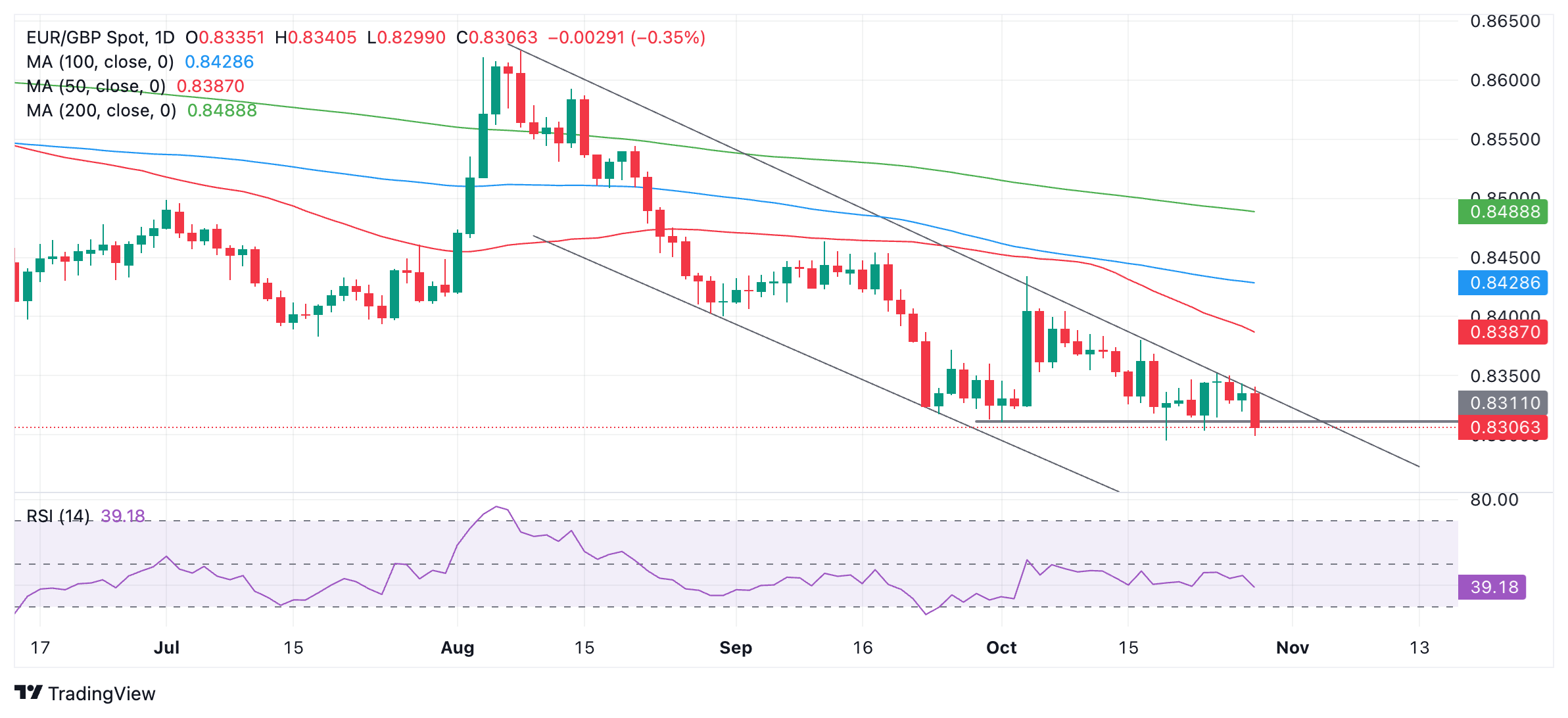- EUR/GBP weakens to almost two-and-a-half year lows on Tuesday on diverging monetary policy expectations.
- Interest rates are expected to fall more quickly in Europe than in the UK, weakening the Euro versus the Pound.
- Wednesday promises to be a big day for the pair with Eurozone GDP data for Q3 and the UK Chancellor presenting the Budget.
EUR/GBP exchanges hands just above 0.8300 on Tuesday, down a quarter of a percent on the day and close to the two-and-a-half year lows of 0.8295 set on October 18. A break below these lows would be a considerable bearish development.
EUR/GBP is falling as the Euro (EUR) depreciates against the Pound Sterling (GBP) due to diverging central bank monetary policy expectations. The European Central Bank (ECB) is foreseen as cutting interest rates lower than the Bank of England (BoE) in the remaining months of 2024 and this is pressuring the Single Currency – and EUR/GBP – lower. This is because currencies with relatively lower interest rates tend to depreciate because of capital outflows.
EUR/GBP Daily Chart

The market’s pricing of Interest Rate Swaps provides a method for predicting what central banks will do in the future, and these are showing “nearly 50% odds of the ECB” cutting interest rates by 50 basis points (bps) (0.50%) at the December meeting, according to Lallalit Srijandorn, Editor at FXStreet. This compares to the UK where, a Reuters poll of economists expect the BoE to cut its Bank Rate by only 25 bps (0.25%) on November 7. In addition, of those surveyed, a nearly-two-thirds majority expect the BoE to leave interest rates unchanged in December.
Recent comments from ECB Governing Council members have on the whole emphasized the possibility of the central bank cutting rates more aggressively since inflation has declined more quickly amid softer-than-expected economic growth.
Commentary somewhat softened so far this week, however, providing some relief to the Euro on Monday. The European Central Bank (ECB) Vice President Luis de Guindos said that the ECB has made significant progress in bringing down inflation but can’t declare victory just yet. Whilst he said “domestic inflation remains high” – implying interest rates should remain elevated – he also highlighted the risks to growth, which by implication could be remedied by lowering interest rates and easing the availability of credit.
Prior to De Guindos, European Central Bank (ECB) policymaker Pierre Wunsch said on Monday that “it is premature to discuss December policy decision.” Further adding that he felt “no urgency in further accelerating easing of monetary policy,” and that the undershoot in September inflation data could be explained as due to lower energy prices from cheaper Oil.
Wednesday could be a pivotal day for EUR/GBP due to the release of preliminary Eurozone Gross Domestic Product (GDP) data for Q3 which will help clarify the growth situation in the region, and the delivery of the UK Budget statement in the UK.
Given the new Labor government’s highlighting of the 22 billion (GBP) black hole in the nation’s accounts left by the previous Conservative government, the UK Budget is likely to incorporate a mixture of higher taxes and moderate government spending. According to Capital Economics, even with higher taxes expected, UK consumers are not reacting by tightening their belts and growth is expected to continue at a “healthy clip”. This suggests Sterling will remain underpinned.
“Overall, there’s little evidence that the prospect of tax rises has caused households to become more cautious with their borrowing. While household borrowing and spending may be a bit softer after the scale of tax rises is revealed in tomorrow’s Budget, our central forecast is that the economy expanded in September and will grow by a decent 0.4% q/q or so in Q4,” says Paul Dales, Chief UK Economist at Capital Economics.
Eurozone GDP data, meanwhile, is expected to show a 0.8% rise in Q3 YoY, from 0.6% in Q2, and a 0.2% increase QoQ, the same as it did in the previous quarter. An undershoot would weaken the Euro and see more losses for EUR/GBP, whilst an overshoot would strengthen the case for a more cautious approach to cutting interest rates reflected in Monday’s commentary and see the Euro, and EUR/GBP recover.
Information on these pages contains forward-looking statements that involve risks and uncertainties. Markets and instruments profiled on this page are for informational purposes only and should not in any way come across as a recommendation to buy or sell in these assets. You should do your own thorough research before making any investment decisions. FXStreet does not in any way guarantee that this information is free from mistakes, errors, or material misstatements. It also does not guarantee that this information is of a timely nature. Investing in Open Markets involves a great deal of risk, including the loss of all or a portion of your investment, as well as emotional distress. All risks, losses and costs associated with investing, including total loss of principal, are your responsibility. The views and opinions expressed in this article are those of the authors and do not necessarily reflect the official policy or position of FXStreet nor its advertisers. The author will not be held responsible for information that is found at the end of links posted on this page.
If not otherwise explicitly mentioned in the body of the article, at the time of writing, the author has no position in any stock mentioned in this article and no business relationship with any company mentioned. The author has not received compensation for writing this article, other than from FXStreet.
FXStreet and the author do not provide personalized recommendations. The author makes no representations as to the accuracy, completeness, or suitability of this information. FXStreet and the author will not be liable for any errors, omissions or any losses, injuries or damages arising from this information and its display or use. Errors and omissions excepted.
The author and FXStreet are not registered investment advisors and nothing in this article is intended to be investment advice.
Recommended content
Editors’ Picks

How will US Dollar react to inflation data amidst all the tariff noise? – LIVE
Investors will take a break from the non-stop headlines surrounding the US tariff policy and scrutinize March Consumer Price Index (CPI) data from the US on Thursday, which could have a significant impact on the Fed policy outlook and the US Dollar's performance.

EUR/USD climbs higher toward 1.1100 ahead of US CPI release
EUR/USD extends its daily rally toward 1.1100 on Thursday as the Euro benefits from the EU's decision to pause countermeasure against US tariffs for 90 days. Meanwhile, the US Dollar remains under pressure ahead of CPI data, further boosting the pair.

Gold clings to gains above $3,110, closes in on all-time high
Gold builds on Wednesday's impressive gains and trades above $3,110 on Thursday. The broad-based selling pressure surrounding the US Dollar and retreating US bond yields on growing fears of a deepening trade war between China and the US fuel XAU/USD's rally.

GBP/USD rises above 1.2900, US CPI data awaited
GBP/USD preserves its bullish momentum and trades above 1.2900 on Thursday. The British Pound capitalizes on risk appetite, courtesy of Trump's tariff pause, allowing the pair to push higher as market focus shits to March inflation data from the US.

Trump’s tariff pause sparks rally – What comes next?
Markets staged a dramatic reversal Wednesday, led by a 12% surge in the Nasdaq and strong gains across major indices, following President Trump’s unexpected decision to pause tariff escalation for non-retaliating trade partners.

The Best brokers to trade EUR/USD
SPONSORED Discover the top brokers for trading EUR/USD in 2025. Our list features brokers with competitive spreads, fast execution, and powerful platforms. Whether you're a beginner or an expert, find the right partner to navigate the dynamic Forex market.



